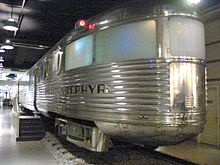Budd (company)
The Budd Company was an American automotive supplier and rail vehicle manufacturer based in Philadelphia and from 1972 in Troy (Michigan) . In the second half of the 20th century, the company was best known for its underground and passenger cars made of stainless steel , the quality and durability of which are considered legendary. The auto parts division is now part of ThyssenKrupp and operates under the name ThyssenKrupp Budd Company .
The company was founded in 1912 by Edward G. Budd as the Edward G. Budd Manufacturing Company and initially produced novel all-steel bodies for the North American automotive industry. For the first time, the spot welding developed by Budd was used, which allowed galvanized and thus stainless steel sheets to be joined together without impairing their corrosion resistance at the welding points. Budd also developed a process to make roofs of closed car bodies (at that time the largest pressed parts of a car) from one piece.
In the following two decades, buses and airplanes were added. From 1934 onwards, the Pioneer Zephyr was built for the Chicago, Burlington and Quincy Railroad, the first vehicle in the largest and best-known fleet of streamlined long-distance trains of the time. They served as a model for the production of railroad cars with superstructures made of stainless steel . In the mid-1930s, the company supplied machines for automobile production worth at least US $ 1.5 million to the Soviet Zavod imeni Stalina , with the help of which the production of the ZIS-101 luxury sedan was built.
After the Second World War , Budd mainly produced large numbers of passenger cars for North American railroad companies. Customers included the Chicago, Burlington and Quincy Railroad (Burlington Route), New York Central Railroad and Santa Fé ; the Pennsylvania Railroad equipped their long-distance trains on the Northeast Corridor with it, most recently in the form of the Metroliner trains. Another product of the company, used by many railroad companies in passenger transport on less popular connections, was the Budd Rail Diesel Car .

With the decline of railroad travel in the United States in the 1960s and 1970s, more and more state and parastatal transportation companies, such as the Southeastern Pennsylvania Transportation Authority (SEPTA), had to operate or at least procure vehicles on suburban routes in major cities. These required new rolling stock in many places, and so Budd turned increasingly to the construction of vehicles for local transport.
As early as 1935, the use of stainless steel car bodies in the construction of subway cars began. The Zephyr was the first prototype for the New York subway in 1935 , followed by another in 1949, the R11. Although both types proved to be reliable, there were no further orders until the early 1960s. Between 1963 and 1984, however, more than 1,900 vehicles were built for various subway systems in the USA, including New York City, Chicago , Miami , the Market – Frankford Line in Philadelphia and the PATCO Speedline .
In 1978, Budd was bought by Thyssen AG for $ 295 million .
At the beginning of the 1980s, Budd had ever greater sales difficulties with rail vehicles. Eventually the rail vehicle division was taken over by competitor Bombardier .
literature
- Vincent R. Courtenay: Ideas that Move America. The Budd Company at 75. Budd Co, Troy MI 1986, OCLC 490067778 .
- Gilbert F. Richards: Budd on the move. Innovation for a nation on wheels (= Newcomen Publication. No. 1008). Newcomen Society in North America, New York NY 1975, OCLC 1272593 .
- Gene Sansone: New York Subways. An illustrated history of New York City's transit cars. Centennial edition. Johns Hopkins University Press, Baltimore MD et al. 2004, ISBN 0-8018-7922-1 . (English, about the New York subway rolling stock)
Individual evidence
- ↑ Konstantin Andrejew: Автолегенды СССР: ЗИС-101 . No. 84, DeAgostini, Moscow 2012.
Web links
- The Philadelphia Chapter of the National Railway Historical Society: The Edward G. Budd Manufacturing Company . 2002-2004. (English)
- Harold E. Spaulding: Budd Co., 1912 . In: Workshop of the World - Philadelphia. Oliver Evans Press, 1990.
Coordinates: 40 ° 0 ′ 29.8 ″ N , 75 ° 10 ′ 8.7 ″ W.

